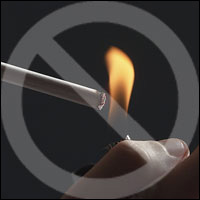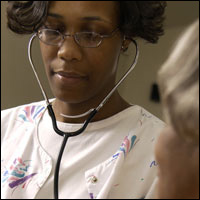Lung Cancer Awareness Month November 2011
Lung Cancer Awareness Month
Every November, the Department of Health and Human Services (HHS) and other organizations join to recognize Lung Cancer Awareness Month, a national campaign aimed at raising attention to lung cancer and its impact on our Nation’s health.
Lung cancer, the leading cause of cancer death in the United States, is largely preventable. About 90 percent of lung cancer deaths among men, and 80 percent of lung cancer deaths among women, are due to smoking.[1] Moreover, tobacco use is the single most preventable cause of death and disease in the United States.[2] Each year, approximately 443,000 Americans die from tobacco-related illnesses. For every person who dies from tobacco use, 20 more people suffer with at least one serious tobacco-related illness,[3] and approximately 130,000 of these deaths are due to lung cancer.[4]
Tobacco use can lead to nicotine dependence and serious health problems. Quitting can significantly reduce the risk of suffering from smoking-related diseases. Tobacco dependence is a chronic condition that often requires repeated interventions, but effective treatments and helpful resources exist. We want to support smokers , many of whom began before they were old enough to make an informed choice. Most smokers want to quit and many do every year. In fact, today there are more former smokers than current smokers.[5] HHS is dedicated to combating this widespread and devastating disease. Guiding the Department’s action in the fight against lung cancer is the HHS Tobacco Control Strategic Action Plan, which aims to create a society free of tobacco-related death and disease. The Plan’s specific, evidence-based actions include strengthening state and local tobacco control efforts; regulating the manufacturing, marketing, and distribution of tobacco products (including requiring new bolder health warnings on cigarette packages and advertisements); expanding access to effective tobacco use cessation treatment; and conducting mass media and education campaigns to prevent initiation among youth, promote cessation among adults and inform the public about the health consequences of tobacco use.
Finally, to build upon our efforts to raise awareness of tobacco prevention and its impact on the nation’s health, this year, the Department included tobacco prevention among the Healthy People 2020 Leading Health Indicators (LHIs). The LHIs highlight current critical health issues that, if remain unaddressed, predict future public health problems. Addressing tobacco use is critical in reducing heart disease, stroke and cancers.
I invite you to join us as we work toward our goal of reducing the incidence of lung cancer across the nation. Supporting our efforts to eliminate tobacco use among adults and adolescents, can improve the future health of all Americans.
Howard K. Koh, M.D., M.P.H.
Assistant Secretary for Health
U.S. Department of Health and Human Services
###
Lung Cancer Awareness
Lung cancer is the leading cause of cancer deaths in both men and women. Smoking causes 80 to 90 percent of cases of lung cancer. Don’t smoke, and avoid secondhand smoke.
> Lung Cancer, the Number One Cancer Killer.
Each year, nearly 200,000 people in the United States are told they have lung cancer and more than 90,000 people die from this disease. Deaths from lung cancer represent about one out of every six deaths from cancer in the U.S.
> Lung Cancer. Risk Factors.

Research has found several causes and risk factors for lung cancer. A risk factor is anything that changes the chance of getting a disease. Lung cancer risk factors include—
- Smoking.
- Secondhand smoke from other people’s cigarettes.
- Radon gas in the home.
- Things around home or work, including asbestos, ionizing radiation, and other cancer-causing substances.
- Medical exposure to radiation to the chest.
- Chronic lung disease such as emphysema or chronic bronchitis.
- Increased age.
> Lung Cancer. Prevention
 You can reduce your risk of developing lung cancer in several ways.
You can reduce your risk of developing lung cancer in several ways.
- Don’t smoke. If you do smoke, quit now.
- Avoid secondhand smoke. There is no risk-free level of secondhand smoke exposure.
- Have your home tested for radon and take corrective actions if high levels are found.
- Avoid unnecessary medical tests that involve X-ray images of the chest.
- Follow health and safety guidelines in the workplace.
CDC helps support a national network of quitlines that makes free “quit smoking” support available by telephone to smokers anywhere in the United States. The toll-free number is 1-800-QUITNOW (1-800-784-8669), or visit smokefree.gov
> Lung Cancer. Symptoms
Different people have different symptoms for lung cancer. Some people don’t have any symptoms at all when first diagnosed with lung cancer. Lung cancer symptoms can be due to the direct effect of growth of cancer cells in the lung, or due to the effect of cancer cells that have spread to other parts of the body. Lung cancer symptoms due to growth of cancer cells in the lung may include—
- Shortness of breath.
- Coughing that doesn’t go away.
- Wheezing.
- Coughing up blood.
- Chest pain.
- Repeated respiratory infections such as bronchitis or pneumonia.
These symptoms can happen with other illnesses, too. Talk to your doctor if you have symptoms that concern you.
> Lung Cancer. Treatment
 Lung cancer is treated in several ways, depending on the type of lung cancer and how far it has spread. Treatments include surgery, chemotherapy, and radiation. People with lung cancer often get more than one kind of treatment.
Lung cancer is treated in several ways, depending on the type of lung cancer and how far it has spread. Treatments include surgery, chemotherapy, and radiation. People with lung cancer often get more than one kind of treatment.
People with lung cancer may want to take part in a clinical trial. Clinical trials study new potential treatment options. Learn more about clinical trials at the National Cancer Institute.
> Lung Cancer. Survivors
People who have been treated for lung cancer may continue to have symptoms caused by the cancer or by cancer treatments (side effects). People who want information about symptoms and side effects should talk to their doctors. Doctors can help answer questions and make a plan to control symptoms.
For more information about symptoms and side effects, visit the National Cancer Institute’s Coping with Cancer.
For information about finding or providing support for people with lung cancer and their caregivers, visit CDC’s Cancer Survivorship
###
[1] National Institutes of Health. National Cancer Institute. Tobacco Statistics Snapshot. Retrieved on October 11, 2011 from http://www.cancer.gov/cancertopics/tobacco/statisticssnapshot
Tobacco Facts
Tobacco is the leading cause of preventable illness and death in the United States. It causes many different cancers as well as chronic lung diseases, such as emphysema and bronchitis, and heart disease.
- Cigarette smoking causes an estimated 443,000 deaths each year, including approximately 49,400 deaths due to exposure to secondhand smoke.
- Lung cancer is the leading cause of cancer death among both men and women in the United States, and 90 percent of lung cancer deaths among men and approximately 80 percent of lung cancer deaths among women are due to smoking.
- Smoking causes many other types of cancer, including cancers of the throat, mouth, nasal cavity, esophagus, stomach, pancreas, kidney, bladder, and cervix, and acute myeloid leukemia.
- People who smoke are up to six times more likely to suffer a heart attack than nonsmokers, and the risk increases with the number of cigarettes smoked. Smoking also causes most cases of chronic obstructive lung disease.
- In 2009, approximately 20.6 percent of U.S. adults were cigarette smokers.
- Nearly 20 percent of high school students smoke cigarettes.
- An estimated 9 percent of high school students use smokeless tobacco.
- Prevention and Cessation of Cigarette Smoking: Control of Tobacco Use (PDQ®)
- Vital Signs: Current Cigarette Smoking Among Adults Aged ≥18 Years – United States, 2009. Morbidity and Mortality Weekly Report. 2010
- Smoking-Attributable Mortality, Years of Potential Life Lost, and Productivity Losses – United States, 2000-2004. Morbidity and Mortality Weekly Report. 2008
- Lung Cancer Prevention (PDQ®)
- 2004 Surgeon General’s Report – The Health Consequences of Smoking
- National Heart, Lung, and Blood Institute: Your Guide to a Healthy Heart
- Youth Risk Behavior Surveillance – United States, 2009. Morbidity and Mortality Weekly Report. 2010
[2] Centers for Disease Control and Prevention. Annual smoking-attributable mortality, years of potential life lost, and economic costs—United States, 1995–1999. MMWR. 2002;51(14):300-3 [cited 2009 Aug 18].
[3] Centers for Disease Control and Prevention. Annual smoking-attributable mortality, years of potential life lost, and economic costs—United States, 1995–1999. MMWR. 2002;51(14):300-3 [cited 2009 Aug 18].
Centers for Disease Control and Prevention. Cigarette smoking among adults and trends in smoking cessation—United States, 2008. MMWR. 2009;58(44):1227-32 [cited 2009 Nov 16].
[4] Centers for Disease Control and Prevention. Smoking-Attributable Mortality, Years of Potential Life Lost, and Productivity Losses—United States, 2000–2004. Morbidity and Mortality Weekly Report 2008;57(45):1226–8 [accessed 2011 Mar 11].
[5] Fiore MC, Bailey WC, Cohen SJ, Dorfman SF, Goldstein MG, Gritz ER, et al. Treating Tobacco Use and Dependence: 2008 Update—Clinical Practice Guidelines. Rockville (MD): U.S. Department of Health and Human Services, Public Health Service, Agency for Healthcare Research and Quality, 2008 [accessed 2010 Jun 2].
###
* The above information is adapted from materials provided by USA Department of Health and Human Services (HHS) and Centers for Disease Control and Prevention( CDC). For over 60 years, CDC has been dedicated to protecting health and promoting quality of life through the prevention and control of disease, injury, and disability. They are committed to programs that reduce the health and economic consequences of the leading causes of death and disability, thereby ensuring a long, productive, healthy life for all people.
** More information at USA Department of Health and Human Services (HHS)





















